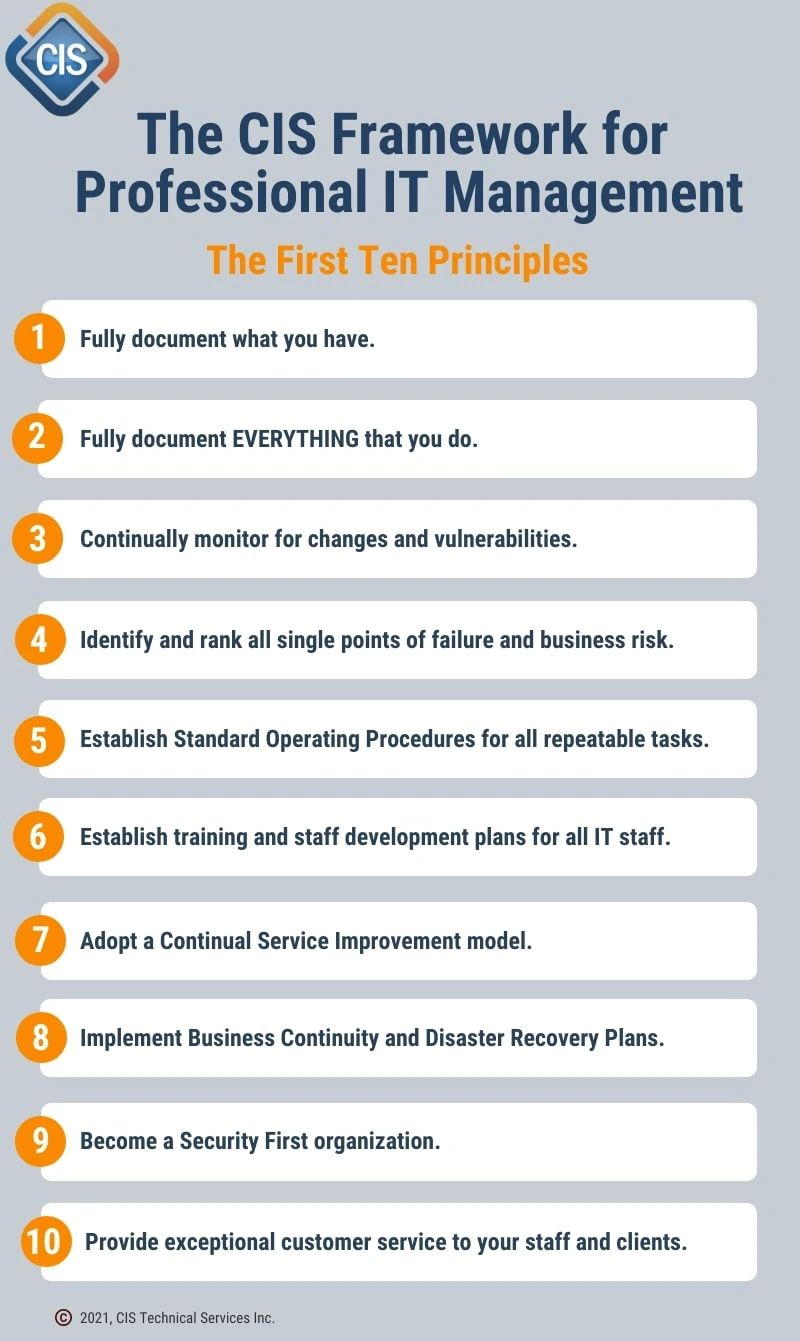
Menu
Business Focused Technology Consulting
CIS can help your business leverage technology, increase efficiency and maximize profitability.

We have been helping businesses embrace and implement new technology for over three decades. So whether you need help with a technology assessment, security, or compliance project or are interested in a top-down review of how technology can help your business grow and prosper, CIS can help.
Small and midsize businesses often operate without a technology roadmap. Projects and budgets are typically organized around upgrading broken or outdated systems rather than embracing innovative technology that can help your business grow and compete. As a result, tech staff and service providers can be relegated to maintaining your current workflow without having insight into the larger vision and strategy of the business owners.
CIS can help bridge the gap between the upper management team, driving vision and strategy, and the tech team responsible for keeping things running.

Once your technology is aligned with your corporate strategy, amazing things become possible. Your business will be built on a solid foundation, utilizing the right technologies, combined with the necessary business capabilities, all in sync with a roadmap that will help your company grow and prosper.
At this point, technology will allow you to work smarter and faster, to enhance and automate things in your business that were not possible before. You will be able to make decisions based on real-time data, which can help you respond to competitive threats, establish new customer value propositions, and adapt to changing customer needs.

A Technology House of Cards?
Small businesses usually have less time, fewer resources, smaller budgets, and fewer choices, than their larger competitors. Management usually spends most of their time working IN the business, rather than ON the business. They rarely have the time or budget required to focus on technology, so it is typically left to an unlucky employee to deal with as best they can, amongst all of their other responsibilities (whether they do it themselves or manage a vendor).
New technology is typically added by just “bolting it on” to the existing systems and workflow without much planning or training. Unfortunately, this can lead to more complexity and single points of failure than is necessary due to how these networks have evolved over time.
There is usually very little documentation, and procedures tend to be very ad-hoc, with everyone doing things their own unique way. Out of necessity, users often find “workarounds” and creative solutions to get the job done. As a result, new employees get “trained” on these techniques without realizing that it may not be the most efficient or secure way to perform the task at hand.
At one point or another, most small businesses end up dependent on mission-critical technology, which was bolted together without a plan. There is no documentation, no user training, and as a result, management has little or no confidence that they are prepared for a significant failure or interruption of service.
If this is your current condition, whether you are a small or a “not so small” business, we can help.
We have the experience, and the resources, to help you shore things up and follow a proven process to eliminate the technology house of cards.
Small businesses usually have less time, fewer resources, smaller budgets, and fewer choices, than their larger competitors. Management usually spends most of their time working IN the business, rather than ON the business. They rarely have the time or budget required to focus on technology, so it is typically left to an unlucky employee to deal with as best they can, amongst all of their other responsibilities (whether they do it themselves or manage a vendor).
New technology is typically added by just “bolting it on” to the existing systems and workflow without much planning or training. Unfortunately, this can lead to more complexity and single points of failure than is necessary due to how these networks have evolved over time.
There is usually very little documentation, and procedures tend to be very ad-hoc, with everyone doing things their own unique way. Out of necessity, users often find “workarounds” and creative solutions to get the job done. As a result, new employees get “trained” on these techniques without realizing that it may not be the most efficient or secure way to perform the task at hand.
At one point or another, most small businesses end up dependent on mission-critical technology, which was bolted together without a plan. There is no documentation, no user training, and as a result, management has little or no confidence that they are prepared for a significant failure or interruption of service.
If this is your current condition, whether you are a small or a “not so small” business, we can help.
We have the experience, and the resources, to help you shore things up and follow a proven process to eliminate the technology house of cards.
Below are the first ten principles of our IT Management Framework for small businesses. Implementing these basic guidelines, whether you have internal IT staff, or outsource the function to a Managed Service Provider, will help provide a solid foundation for success.



Is your workflow standardized, efficient, and secure? Are you getting the maximum value from your tech investments?”

With Ad-hoc systems, no single person fully understands how the patchwork of software and systems works together, what to do when there are problems, or how to be sure that your staff is using them properly and safely. Someone needs to be driving the process to ensure your systems are secure, and your business needs are being met; there is no auto-pilot.
It’s no wonder many small business owners feel trapped in a cycle of never-ending inefficiency, business risks, and escalating costs. Larger companies can easily master the latest technologies and security threats, and they have dedicated people focusing on efficiency and proactive Risk Management, while many small companies are stuck in a continuous cycle of Crisis Management.
In Phase 2 of our Tech Evolution Model, we help you transform from an Ad-hoc workflow to a structured system of procedures for the most critical functions of your business. We follow a proven process that guides you through Phase 2. We help optimize your workflow and manage the technology needed to run your business.
Ad-hoc
Ad-hoc
Every business deserves access to the tools and processes their larger competitors use to scale, allowing them to eliminate waste, narrow the competitive gap, and grow. CIS is certified in the Digital Maturity Group Framework, which helps us gauge IT operations and workflow efficiency across all aspects of your business. We can help streamline & automate problematic processes and convert technology investments into measurable business results.


Our consultants are experts in the DMG Tools & Process and are DMG Certified Digital Advisors.
Information Technology tools are more robust, more flexible, and more capable than ever. Still, with today’s rapid pace of change, business leaders are finding it harder to know where they stand with technology and how to maintain a competitive edge in this rapidly changing digital landscape. We follow a proven process for assessing how your existing IT execution and management supports the company’s overall competitiveness to achieve more market share, better margins, and smoother operation.
Business Improvement Review
Digital Maturity Assessment
Dx Discovery Workshops
Dx Execution Process
“Is your business positioned for sustainable growth?
How is technology changing your competitive landscape?”

In phase three, with all of the technical and workflow issues under control, we can focus on the big picture.
The CIS team is certified in the ionology Digital Transformation Framework, which provides a proven methodology and educational foundation to guide organizations through phase three. The ionology Framework was developed by Prof. Niall McKeown and is recognized as one of the midmarket’s leading and most practical methodologies. For the full experience, including leadership training, we combine our services with ionology expert-led courses to help guide your strategy development and corporate culture.
(Part of the Ionology Framework)
Without current and complete data, you will lack insight, and be unable to make evidence based decisions to keep up with constant change.
Technology enables Digital Transformation, it is imperative that your systems are built on a solid foundation using the correct technology.
Without these, incoherent action occurs and roadblocks seem insurmountable.
If engagement with stakeholders is wrong, it leads to resistance.
The most critical building block, without a coherent strategy, efforts result in stand alone digitization projects.
Our consultants are certified in the ionology Digital Transformation Framework, which provides a proven methodology and educational foundation to guide organizations through phase three. Click Here to learn more about the ionology Framework and courses, available in person or online.
Technology is only one of the 5 Change Blocks of Digital Transformation.
Strategy, engagement, innovation, and data are all equally important and require leadership attention; without which, digital transformation will not succeed.
Some businesses set out to digitally transform, but instead, they drift, upgrade, and tweak systems as they go but generally still do business the way they always have. Instead of evolving and innovating, many companies digitize and stop.
Often, they have been mis-sold the idea that more technology = greater competitive advantage.
Technology is just a tool, and with today’s abundance of cloud-enabled apps and other disruptive technologies, even the smallest businesses have access to technology that would have been unobtainable for them just a few short years ago. If you are not strategic about using technology to differentiate your business, you will be at risk of being left behind.
